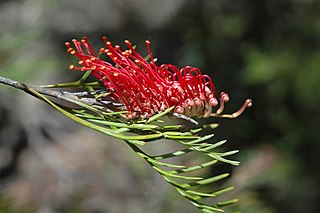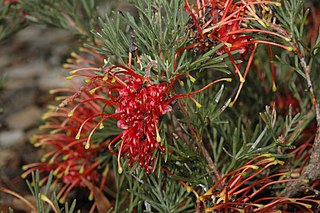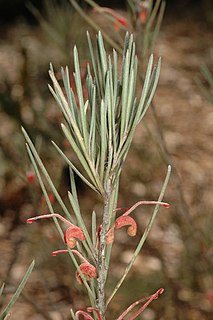
Grevillea fililoba is a species of flowering plant in the family Proteaceae and is endemic to a restricted area in the south-west of Western Australia. It is a spreading shrub with soft foliage, divided leaves with narrow linear lobes, and clusters of pink to bright red and white flowers.

Grevillea curviloba is a species of flowering plant in the family Proteaceae and is endemic to the south-west of Western Australia. It is a prostrate to erect shrub with short branchlets, divided leaves with linear to narrowly lance-shaped lobes with the narrower end towards the base, and white to cream-coloured flowers.

Grevillea bipinnatifida, commonly known as fuchsia grevillea, is a species of flowering plant in the family Proteaceae and is endemic to the south-west of Western Australia. It is a spreading shrub, usually with bipinnatifid leaves and loose clusters of dull pink to crimson flowers.

Grevillea concinna, commonly known as red combs or elegant grevillea, is a species of flowering plant in the family Proteaceae and is endemic to the south-west of Western Australia. It is a spreading to erect shrub with mostly linear to narrow wedge-shaped leaves sometimes with a sharp point on the tip. Flower colour varies with subspecies.

Grevillea corrugata is a species of flowering plant in the family Proteaceae and is endemic to a restricted area in the south-west of Western Australia. It is a dense shrub with deeply divided leaves usually with three to five sharply-pointed, linear lobes, and white to cream-coloured flowers.

Grevillea hookeriana, commonly known as red toothbrushes or Hooker's grevillea, is a species of flowering plant in the family Proteaceae and is endemic to the south-west of Western Australia. It is a spreading to erect shrub, usually with linear leaves or deeply divided leaves with linear lobes, and toothbrush-shaped groups of red, black or yellowish green flowers, the style maroon to black.

Grevillea agrifolia, the blue grevillea, is a species of flowering plant in the family Proteaceae and is native to the north of Western Australia and parts of the Northern Territory. It is a shrub or tree with narrowly oblong leaves with the narrower end towards the base, and creamy-yellow flowers.

Grevillea diversifolia, the variable-leaved grevillea, is a species of flowering plant in the family Proteaceae and is endemic to the south-west of Western Australia. It is an erect to prostrate shrub with simple or divided leaves and groups white to cream-coloured flowers with a dull red style.

Grevillea biformis is a species of flowering plant in the family Proteaceae and is endemic to the south-west of Western Australia. It is a shrub with linear leaves and cylindrical clusters of creamy white or pale pink flowers.

Grevillea dryandroides, commonly known as phalanx grevillea, is a species of flowering plant in the family Proteaceae and is endemic to the south-west of Western Australia. A diffuse, clumping shrub, it often forms suckers and has divided leaves with up to 35 pairs of leaflets, and groups of red to pinkish flowers on an unusually long, trailing peduncle.

Grevillea althoferorum, commonly known as the split-leaved grevillea, is a species of flowering plant in the family Proteaceae and is endemic to a restricted area of Western Australia. It is a compact, rounded shrub with sharply-pointed, deeply lobed leaves and dull yellow flowers with a creamy-yellow style.

Grevillea bracteosa, also known as bracted grevillea, is a species of flowering plant in the family Proteaceae and is endemic to the south-west of Western Australia. It is an erect to spreading shrub usually with linear leaves, and oval to more or less spherical clusters of glabrous pale green to greenish-pink flowers with a pink or white style.

Grevillea amplexans is a species of flowering plant in the family Proteaceae and is endemic to the Mid West region of Western Australia. It is a spreading shrub with arching branches, stem-clasping, sharply-pointed, lobed or toothed leaves and white to cream-coloured flowers.

Grevillea coccinea is a species of flowering plant in the family Proteaceae and is endemic to the south of Western Australia. It is a low-lying or sprawling shrub with narrowly wedge-shaped to linear leaves and white, cream-coloured, and red or yellow flowers.
Grevillea crowleyae is a species of flowering plant in the family Proteaceae and is endemic to a restricted area in the south-west of Western Australia. It is a dense, spreading shrub with deeply divided leaves usually with three to seven linear lobes, and grey, pale yellowish or greenish flowers with a maroon-black style.

Grevillea delta is a species of flowering plant in the family Proteaceae and is endemic to restricted area in the south-west of Western Australia. It is a bushy, spreading shrub with hairy branchlets, divided leaves with linear lobes, and groups of red flowers with a red, green-tipped style.
Grevillea dolichopoda is a species of flowering plant in the family Proteaceae and is endemic to the south-west of Western Australia. It is a low-lying shrub with linear to more or less cylindrical leaves and groups up to four red and orange flowers with a red, green-tipped style.

Grevillea haplantha is a species of flowering plant in the family Proteaceae and is endemic to the south-west of Western Australia. It is a dense, rounded shrub with linear leaves and clusters of pink to red flowers with white or brown hairs, depending on subspecies.
Grevillea uniformis is a shrub of the genus Grevillea native to a small area along the west coast in the Wheatbelt region of Western Australia.
Grevillea xiphoidea is a shrub of the genus Grevillea native to an area in the Wheatbelt region of Western Australia.

















